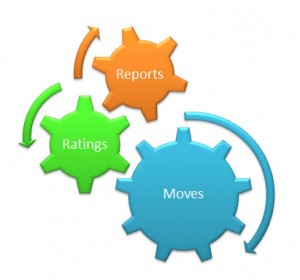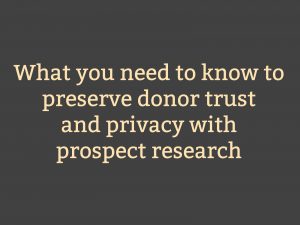
You know that managing and using your donor data is becoming increasingly important to fundraising success and now you have a person designated to perform prospect research tasks for you. Congratulations!
Do you have any idea what your prospect researcher should be doing?
I have three suggestions that will put you and your researcher on a productive path in no time!
1 – Budget for Serious Training
Prospect research is a broad skill set that requires training and practice over time. It involves so much more than putting a prospect name into a search engine or software subscription. It is about using data to drive fundraising strategies. That means understanding fundraising *and* how to research. And that means training. Seriously consider sending new and experienced researchers to the Association of Professional Researchers for Advancement (APRA)’s national conference. Get a grant or a scholarship. Just do it. Even if she sleeps through half of it you should notice significant productivity gains when she returns – it’s that good!
Also, it should not be overlooked that prospect research can be a painful hot button if your board and staff are not well educated on how it works. Your researcher needs to understand how to perform her job ethically and responsibly and be able to communicate that to others.
2 – Ask Really Good Questions
As a front-line fundraiser you should know what is in your overall fundraising plan and what your goals are for the year. Based on that knowledge you need to begin asking your researcher really good questions. Such as…
We are going to add planned giving prospects to our major gift pools. How many of our donors have a lifetime giving of more than $$, and have given more than once a year for the past 2-5 years? And of those, how many live in a geographic area where we can visit without significant expense?
Hopefully, it is obvious how asking good questions related to your goals could open up productive conversations with your researcher. Now she can say things like…
I noticed a cluster of matching zip codes so I reviewed the names. Did you know that one of our trustees lives in a community with 10 percent of the people on the list you asked for?
Now I bet you are asking, “I thought researchers did prospect profiles?” We do that too. Proactive research identifies opportunities through data. Reactive research, like prospect profiles, gives you the information edge to maximize giving.
3 – Include Researchers in Fundraising Discussions
A trained researcher who is engaged in the conversation around using data is a marvelous asset to your team. So be sure to include her in your fundraising discussions. Musing over a capital campaign? She could have a LOT to add about who is in your database and best practices and trends in research used by similar organizations.
But I’m not just talking about formal meetings or discussions. After your meeting with a donor, mention new information or strategy you are thinking about. Was the ask amount on target with the wealth information found? Debriefing your researcher means she can learn and grow, providing you with more and better information next time.
Prospect Research Adds Value – So Value Your Researcher
It is virtuous circle – the better trained and engaged your researcher is, the better able she is to help you raise more money. And thankfully, researchers are often independent learners. If you can communicate your fundraising objectives and where you think research could provide support, your researcher can probably figure out and communicate to you the best practices in the field.
These conversations might pull you and your researcher out of your comfort zones for a while, but your efforts will be well rewarded by more dollars raised for your mission. And heck, you’ll probably have more fun at work too!
Jen Filla founded Aspire Research Group so that every development office could have the benefits of professional prospect research. Known for her creativity and clear communications, she uses her direct fundraising experience to craft research solutions for organizations across the country that answer the questions that lead to more and higher gifts, guiding fundraisers comfortably every step of the way.
Other Posts You Might Like
3 Actions That Demonstrate Your High Prospect Research IQ
The Dangers of (Not) Managing Prospect Research
Can you really trust prospect research? 10 things you should know









